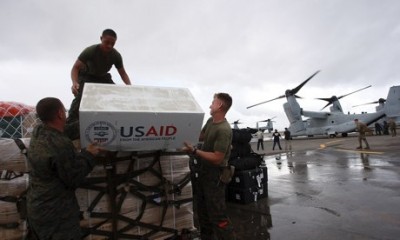US Military Continues Massive Build-Up in Philippine Disaster Zone, Took Over Air Traffic in Tacloban

The death toll in the central Philippines continues to mount in the wake of the devastation caused by Typhoon Haiyan. The current official count of the Philippine government National Disaster Risk Reduction and Management Council (NDRRMC) was 4,881 dead as of noon, November 18. This number will continue to increase sharply, as mass casualties in more remote areas begin to be processed.
An estimated 2 million people are homeless, while a total of 11 million are reported to have been affected by the damage. Vast portions of the islands of Samar and Leyte have been laid waste by the storm, and the city of Tacloban is in ruins.
The islands are in the grip of an immense humanitarian crisis. Hundreds of thousands are without access to food, potable water, medicine, or sanitation. Roads throughout the islands remain impassible, and entire communities are completely isolated.
Washington has deployed a massive military force to the region. The nuclear powered aircraft carrier USS George Washington, with 5,000 sailors and 80 aircraft, is in the Leyte Gulf, along with its strike group of two guided-missile cruisers, two guided-missile destroyers, a cargo ship, an oceanographic survey ship and a submarine tender. These are to be joined by 3 amphibious warfare ships and 2 littoral combat ships. Some 850 US troops are on the ground in Leyte and are to be joined by an additional 1,000 US Marines in the next two days.
Joint Task Force 505, under the command of Marine Corps Lt. Gen. John E. Wissler, has set up headquarters for the US forces in Camp Aguinaldo, the military headquarters of the Philippine Army.
While this build-up is referred to as “providing assistance,” it is clear that the US military is just not “assisting” their Philippine counterparts, but commanding them. US forces are operating the air traffic control tower at the Tacloban airport, controlling which flights are allowed to land and take off there.
“We are controlling 250 ops (operations) per day,” U.S. Air Force Master Sgt. Clinton Dykes told the US military publication Stars and Stripes on November 15. The number of operations has increased significantly since then.
The Philippine military is being deployed as armed crowd control in the city of Tacloban, implementing a de facto system of martial law, with an 8 pm–6 am curfew. The hundreds of armed military and police patrolling streets are further supplemented by the armed private guards who defend the homes and property of the wealthy.
The chapel and museum in Tacloban constructed by, and dedicated to, Imelda Marcos still stand. In the immediate aftermath of the storm, as tens of thousands desperately sought shelter, armed guards threatened to kill anyone who attempted to enter the locked museum, whose 21 rooms housed countless treasures including Ming dynasty vases and gifts from Mao Zedong.
The International Labor Organization (ILO) announced on Tuesday that 5 million workers, roughly a quarter of all those employed in the Philippines, have been affected by Typhoon Haiyan. The United Nations World Food Program stated that, as of November 19, around 600,000 residents of the Eastern Visayas region had not yet received aid packages.
Reports from volunteer workers surfaced in social media over the past two days, revealing that one of the reasons for the Philippine government’s delayed delivery of food supplies was that international aid packages containing bottled water, canned goods and powdered milk were being individually opened and repackaged with labels from the Department of Social Welfare and Development (DSWD).
Other aid packages were labeled with the names of individual local politicians; many bags went out labeled as being from the Vice President Jejomar Binay.
The population in Tacloban is now being subjected to a “food for work” program. The distribution of food aid to the residents of Tacloban has been made contingent upon their completing a certain amount of unpaid work for the city.
What aid has been made available to the Eastern Visayas by the Philippine government is allocated on the basis of the National Disaster Relief Law. The portion of the emergency disaster relief budget allocated to any particular local government unit (LGU), such as a town or city, is based on a percentage of the LGU’s revenue.
Thus, a wealthy city will automatically have greater aid allocated to it, while a poorer town or city will receive a significantly smaller amount.
No money had been set aside to prepare for natural disasters. In 2011, President Aquino vetoed the allocation of any funds for so-called “pre-disaster preparations,” including the construction and stocking of evacuation centers. Aquino declared at the time that any allocated funds should be used for “actual calamities and not for the preparation of relocation sites/facilities, and training personnel engaged in direct disaster.”
With its massive deployment of armed force, Washington is seizing the opportunity afforded it by the catastrophe to stage an immense photo op. It is using the devastation in the central Philippines to demonstrate the capacity of its armed forces in the region and to open the door for its military build-up throughout the region directed against China.
The irrationality of capitalism is laid starkly bare by the fact that in order for aid to be delivered to a humanitarian crisis affecting millions of people, it is the military that is deployed, as rescue operations and infrastructure are absent. Despite the construction of huge numbers of cargo ships in the region, warships are the only vessels made available to deliver food aid, and amphibious assault vessels carry basic medical supplies.

